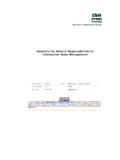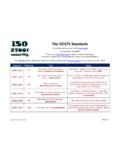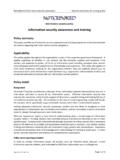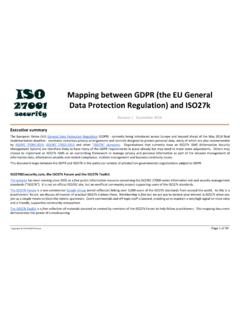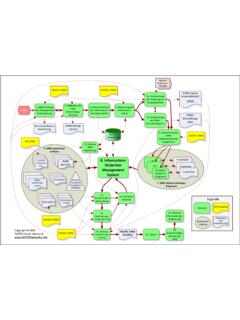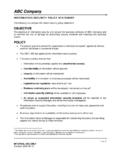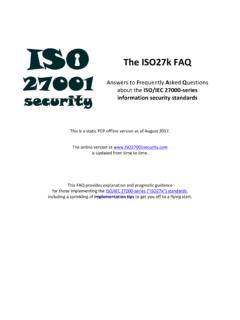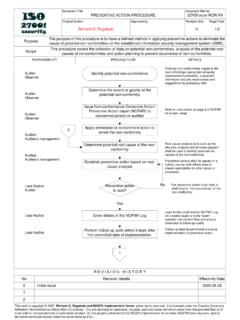Transcription of Malware (malicious software) - ISO27001security
1 Malware policy Copyright 2018 IsecT Ltd. Page 1 of 6 Information security policy Malware (malicious software) Policy summary Malware is a serious threat to the organization, therefore effective Malware controls are essential. Where technically feasible, approved antivirus software must run continuously on all relevant devices, and be updated frequently. Further technical and procedural controls are necessary to address Malware risks, including effective incident response, backups and other business continuity and contingency arrangements in case of serious incidents. Applicability This policy applies throughout the organization as part of the corporate governance framework. It is particularly relevant to IT users and administrators and applies to all computing and network platforms. This policy also applies to third party employees working for the organization whether they are explicitly bound ( by contractual terms and conditions) or implicitly bound ( by generally held standards of ethics and acceptable behavior) to comply with our information security policies.
2 Policy detail Background This policy concerns computer viruses, network worms, Trojan horse programs, rootkits, keyloggers, trapdoors, backdoors, adware, spyware, crimeware, scareware, ransomware, cryptominers, Advanced Persistent Threats (APTs) etc., collectively known as Malware (a contraction of malicious software). Malware poses a serious threat to the organization because it is commonplace, highly variable, very difficult to detect and almost impossible to block completely. Modern Malware is so technically advanced ( remotely controlled, reconfigurable and capable of being redirected to attack multiple targets) that we cannot completely rely on preventive and detective controls. Worse still, Malware incidents can be highly damaging, affecting the security of business information leading to serious consequences such as business interruption, privacy breaches and other compliance failures, loss/theft/devaluation of intellectual property, extortion, theft from online bank accounts and safety incidents.
3 Malware is being actively developed, traded and used by: Individuals for personal reasons (such as spying on their partners and work colleagues or accessing confidential proprietary information); Criminals to commit fraud, identity fraud, information theft, coercion, blackmail, sabotage etc.; Unethical adversaries to commit industrial espionage, steal intellectual property, sabotage business processes and commercial bids etc.; and Malware policy Copyright 2018 IsecT Ltd. Page 2 of 6 Hackers, journalists, private investigators, law enforcement, the security services, government agencies and others for various reasons including national security and, potentially, cyberwar. Policy axiom (guiding principle) Complementary layers of protection must be used to counter Malware : All reasonable steps must be taken to avoid and prevent Malware infections, including both technical/automated and procedural/manual controls; and Appropriate detective and corrective controls must also be in place to identify and minimize the impacts of Malware infections that are not avoided or prevented by the other controls.
4 Detailed policy requirements 1. Points on the network perimeter through which Malware can enter the organization from outside should be limited and controlled, yet without unduly interfering with legitimate network use. Only IT-approved network firewalls may be used, for example. 2. Personally-owned ICT (Information and Communications Technology) devices may only be used for business purposes if duly authorized under the corporate BYOD (Bring Your Own Device) scheme. MDM (Mobile Device Management) software must be installed and configured to permit remote management of BYOD devices by IT, and where applicable corporate antivirus software must be used and maintained. 3. Further controls are necessary to prevent or at least limit the infection and spread of Malware within the organization and prevent (as far as possible) Malware leaving the organization by any route including network connections and data storage media.
5 4. Regular data backups must be taken to off-line storage media at frequencies determined by the backup policy, Information Security Management and/or the applicable Information or Risk Owners. Backups should be retained for at least three months to facilitate recovery of uninfected data files if Malware infections are subsequently determined*. 5. Emails traversing the email gateways (both inbound and outbound) must be automatically scanned for Malware using IT-approved email antivirus software. Any infected messages must be quarantined pending review and disinfection or deletion by suitable IT professionals. 6. Executable attachments (including those inside archives such as zip files, or with non-standard file extensions) should be routinely blocked or stripped from both inbound and outbound emails at the email gateways. Given legitimate business needs, email users can request that executable attachments are virus-scanned and released from quarantine if uninfected.
6 7. All ICT devices should be configured, maintained, monitored and patched to minimize operating system and application vulnerabilities, including those that could lead to Malware infections. Critical security patches should be applied as soon as practicable following successful testing. End-of-life software that is out of support and no longer maintained or patched by the supplier should be retired from service at the earliest opportunity. * Note: in most cases, business and compliance requirements dictate that backups and archives be retained for substantially longer than the three-month minimum noted here, sometimes for years. Malware policy Copyright 2018 IsecT Ltd. Page 3 of 6 8. Wherever technically possible, IT-approved antivirus software must run continuously on all applicable IT systems ( desktop PCs, servers, laptops, tablets, smartphones and Internet of Things things), automatically scanning fixed and removable storage media and isolating any Malware detected.
7 Malware signature files should be updated as often as practicable, ideally by direct download from the antivirus software vendors. In the case of IT systems supporting critical business processes, the corresponding Information or Risk Owners may however insist that antivirus updates are routinely tested prior to implementation if the risks of inappropriate changes outweigh the risks of Malware infection and compromise. 9. Software intended for business- or safety-critical systems may have to be reviewed in detail by technically competent and independent persons for Malware if the corresponding Information or Risk Owners require it ( for legal and regulatory compliance reasons). Further risk analysis and preventive measures may be appropriate within the software development, testing, implementation and maintenance processes. Automatic file integrity checks should be used routinely to monitor file systems on critical systems for unauthorized changes, including those potentially indicating Malware infections.
8 This requirement applies to new software developments and to updates, patches or maintenance releases, whether developed externally or in-house, and allows for code reviews to occur at any time ( by scanning source code libraries/databases for malicious embedded functions). 10. Trustworthy software installation media (ideally the original CD- or DVD-ROMs, or checksum-verified downloads direct from software suppliers) should be retained to enable re-installation of known-good operating systems and application programs in the event that this is the only safe means of recovery. For critical systems, it may be necessary to replace hardware such as motherboards, hard drives and network cards whose firmware/software might have been compromised by Malware . 11. IT users, IT system administrators, Help Desk workers and other IT support staff must be informed of and remain alert to the Malware risk through suitable awareness, training and educational activities, including the briefings/guidelines and procedures supporting this policy.
9 Workers who discover or suspect Malware incidents must report them without delay to the Help Desk and follow their instructions. 12. Strong incident management and business continuity arrangements (including resilience, recovery and contingency aspects) are essential in case of serious Malware infections, outbreaks and incidents arising. Although these arrangements are used routinely on relatively minor Malware incidents and concerns, realistic exercises must be held periodically to simulate and rehearse the response to more serious or unusual incidents involving Malware . 13. It is particularly important that workers do not disclose or discuss Malware incidents with outsiders unless explicitly authorized ( official press releases and briefings). Refer all queries to the Help Desk or Public Relations. 14. Malware incidents and related near-misses must be recorded by Help Desk for statistical reporting and continuous improvement purposes.
10 Post-incident reviews should be completed to analyze significant Malware infections and any others where management feels it appropriate and worthwhile to examine control weaknesses and where necessary improve preventive, detective and/or corrective Malware controls. Malware policy Copyright 2018 IsecT Ltd. Page 4 of 6 15. Computer media believed to carry a significantly greater risk of Malware infection, including all data storage media (both originals and backups) associated with an infected system and/or its users, should be virus-scanned and ideally disinfected on an isolated and safe test environment, wiped to a forensically sound standard, or physically destroyed. 16. Anybody who deliberately or carelessly interferes with the correct operation of antivirus and related Malware controls may be subject to disciplinary procedures or legal measures, particularly if their actions significantly increase the risk of Malware infections or lead to a damaging incident.
